NUR231 - Case Study: Safe Clinical Administration of Patient 7
VerifiedAdded on 2022/09/05
|10
|2689
|13
Case Study
AI Summary
This case study examines the safe clinical administration of medication for Patient 7, covering a range of critical aspects. It begins by defining key terms like tachycardia, tachypnea, angina, hypertension, anxiety, and tremors, providing examples of observational data. The study then explores immediate actions for assessing and monitoring symptoms, including the use of ECGs. A detailed explanation of asthma pathophysiology is provided, along with generic details, indications, and actions of medications such as Serevent (salmeterol) and Albuterol (Ventolin). Furthermore, the case delves into Graves' disease, its symptoms, and antithyroid drug treatments, including Methimazole and Propylthiouracil (PTU). The rationale for combining drug therapies is discussed, considering potential interactions with bronchodilators. Finally, the case concludes with a simulated nurse-patient interaction, offering advice to the patient, Jolene, regarding her conditions, drug therapy, and its implications during pregnancy, emphasizing professional codes and standards.
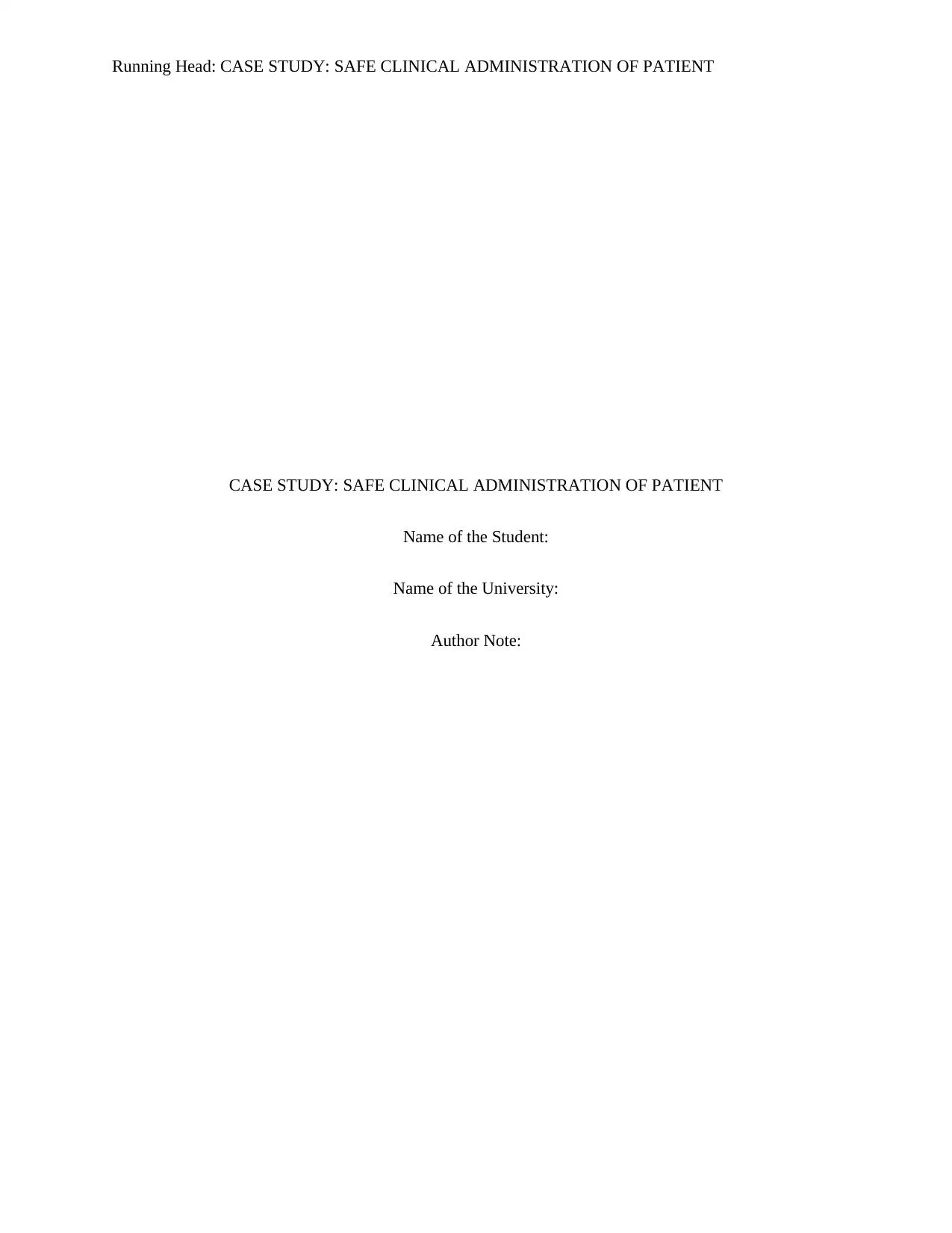
Running Head: CASE STUDY: SAFE CLINICAL ADMINISTRATION OF PATIENT
CASE STUDY: SAFE CLINICAL ADMINISTRATION OF PATIENT
Name of the Student:
Name of the University:
Author Note:
CASE STUDY: SAFE CLINICAL ADMINISTRATION OF PATIENT
Name of the Student:
Name of the University:
Author Note:
Paraphrase This Document
Need a fresh take? Get an instant paraphrase of this document with our AI Paraphraser
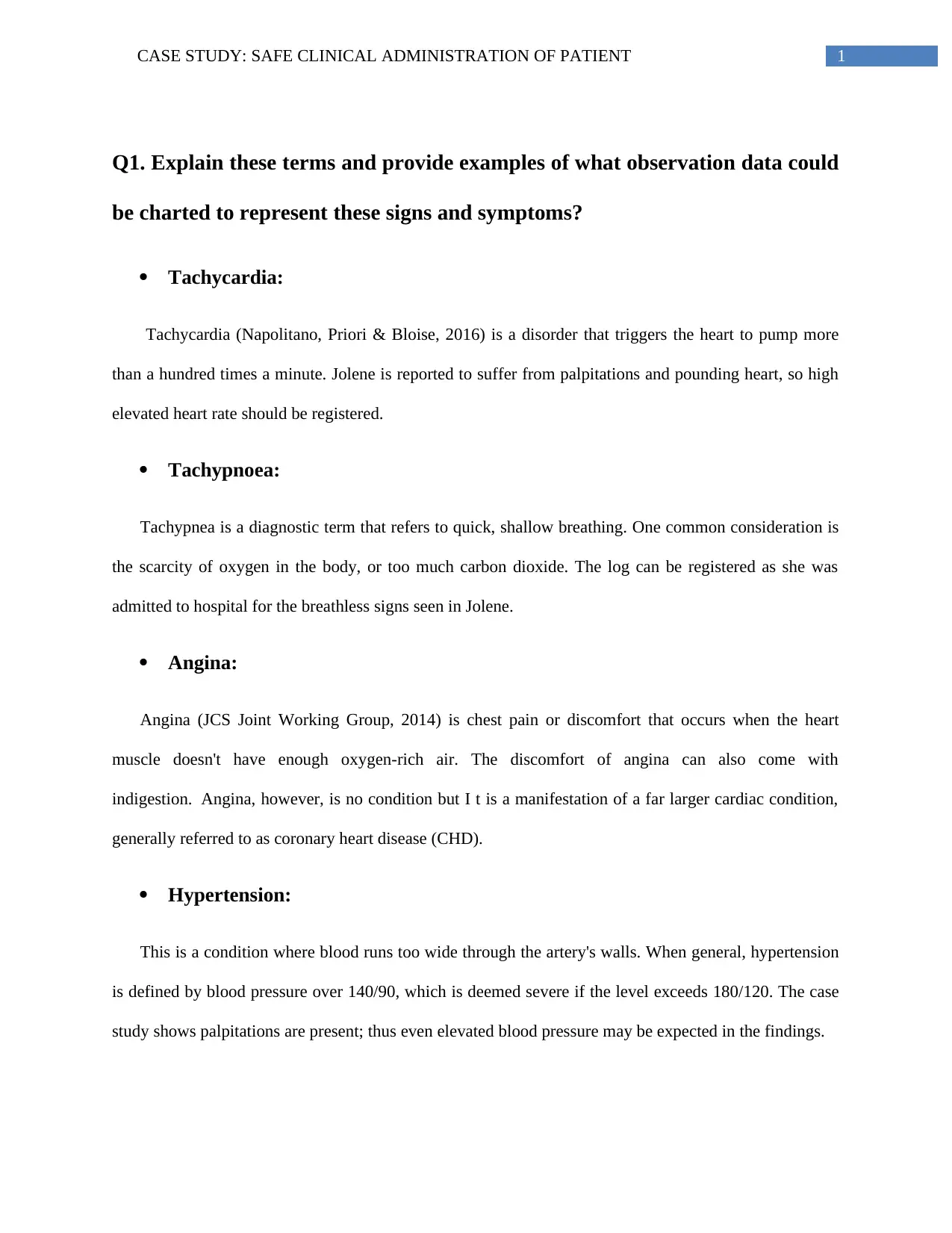
1CASE STUDY: SAFE CLINICAL ADMINISTRATION OF PATIENT
Q1. Explain these terms and provide examples of what observation data could
be charted to represent these signs and symptoms?
Tachycardia:
Tachycardia (Napolitano, Priori & Bloise, 2016) is a disorder that triggers the heart to pump more
than a hundred times a minute. Jolene is reported to suffer from palpitations and pounding heart, so high
elevated heart rate should be registered.
Tachypnoea:
Tachypnea is a diagnostic term that refers to quick, shallow breathing. One common consideration is
the scarcity of oxygen in the body, or too much carbon dioxide. The log can be registered as she was
admitted to hospital for the breathless signs seen in Jolene.
Angina:
Angina (JCS Joint Working Group, 2014) is chest pain or discomfort that occurs when the heart
muscle doesn't have enough oxygen-rich air. The discomfort of angina can also come with
indigestion. Angina, however, is no condition but I t is a manifestation of a far larger cardiac condition,
generally referred to as coronary heart disease (CHD).
Hypertension:
This is a condition where blood runs too wide through the artery's walls. When general, hypertension
is defined by blood pressure over 140/90, which is deemed severe if the level exceeds 180/120. The case
study shows palpitations are present; thus even elevated blood pressure may be expected in the findings.
Q1. Explain these terms and provide examples of what observation data could
be charted to represent these signs and symptoms?
Tachycardia:
Tachycardia (Napolitano, Priori & Bloise, 2016) is a disorder that triggers the heart to pump more
than a hundred times a minute. Jolene is reported to suffer from palpitations and pounding heart, so high
elevated heart rate should be registered.
Tachypnoea:
Tachypnea is a diagnostic term that refers to quick, shallow breathing. One common consideration is
the scarcity of oxygen in the body, or too much carbon dioxide. The log can be registered as she was
admitted to hospital for the breathless signs seen in Jolene.
Angina:
Angina (JCS Joint Working Group, 2014) is chest pain or discomfort that occurs when the heart
muscle doesn't have enough oxygen-rich air. The discomfort of angina can also come with
indigestion. Angina, however, is no condition but I t is a manifestation of a far larger cardiac condition,
generally referred to as coronary heart disease (CHD).
Hypertension:
This is a condition where blood runs too wide through the artery's walls. When general, hypertension
is defined by blood pressure over 140/90, which is deemed severe if the level exceeds 180/120. The case
study shows palpitations are present; thus even elevated blood pressure may be expected in the findings.
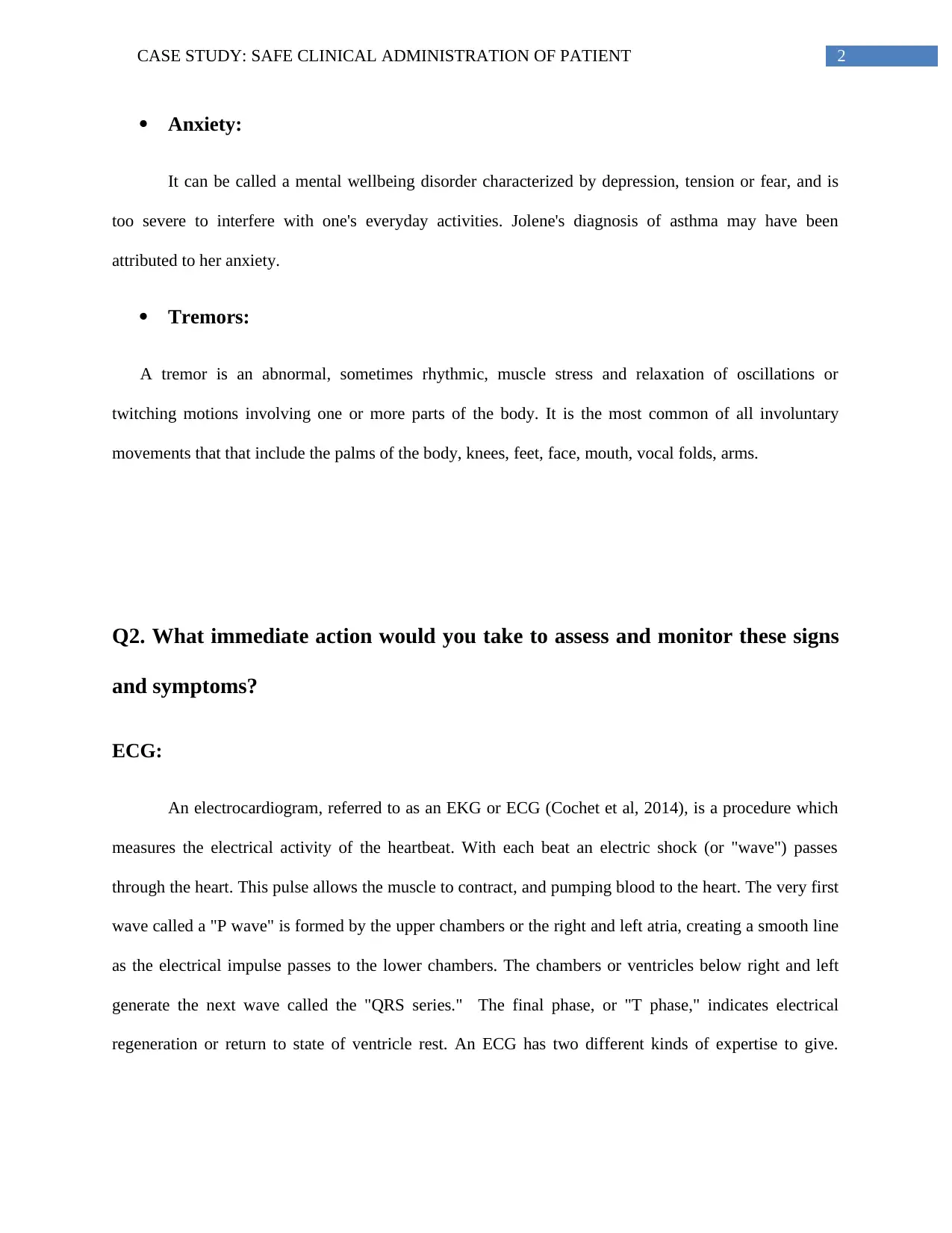
2CASE STUDY: SAFE CLINICAL ADMINISTRATION OF PATIENT
Anxiety:
It can be called a mental wellbeing disorder characterized by depression, tension or fear, and is
too severe to interfere with one's everyday activities. Jolene's diagnosis of asthma may have been
attributed to her anxiety.
Tremors:
A tremor is an abnormal, sometimes rhythmic, muscle stress and relaxation of oscillations or
twitching motions involving one or more parts of the body. It is the most common of all involuntary
movements that that include the palms of the body, knees, feet, face, mouth, vocal folds, arms.
Q2. What immediate action would you take to assess and monitor these signs
and symptoms?
ECG:
An electrocardiogram, referred to as an EKG or ECG (Cochet et al, 2014), is a procedure which
measures the electrical activity of the heartbeat. With each beat an electric shock (or "wave") passes
through the heart. This pulse allows the muscle to contract, and pumping blood to the heart. The very first
wave called a "P wave" is formed by the upper chambers or the right and left atria, creating a smooth line
as the electrical impulse passes to the lower chambers. The chambers or ventricles below right and left
generate the next wave called the "QRS series." The final phase, or "T phase," indicates electrical
regeneration or return to state of ventricle rest. An ECG has two different kinds of expertise to give.
Anxiety:
It can be called a mental wellbeing disorder characterized by depression, tension or fear, and is
too severe to interfere with one's everyday activities. Jolene's diagnosis of asthma may have been
attributed to her anxiety.
Tremors:
A tremor is an abnormal, sometimes rhythmic, muscle stress and relaxation of oscillations or
twitching motions involving one or more parts of the body. It is the most common of all involuntary
movements that that include the palms of the body, knees, feet, face, mouth, vocal folds, arms.
Q2. What immediate action would you take to assess and monitor these signs
and symptoms?
ECG:
An electrocardiogram, referred to as an EKG or ECG (Cochet et al, 2014), is a procedure which
measures the electrical activity of the heartbeat. With each beat an electric shock (or "wave") passes
through the heart. This pulse allows the muscle to contract, and pumping blood to the heart. The very first
wave called a "P wave" is formed by the upper chambers or the right and left atria, creating a smooth line
as the electrical impulse passes to the lower chambers. The chambers or ventricles below right and left
generate the next wave called the "QRS series." The final phase, or "T phase," indicates electrical
regeneration or return to state of ventricle rest. An ECG has two different kinds of expertise to give.
⊘ This is a preview!⊘
Do you want full access?
Subscribe today to unlock all pages.

Trusted by 1+ million students worldwide
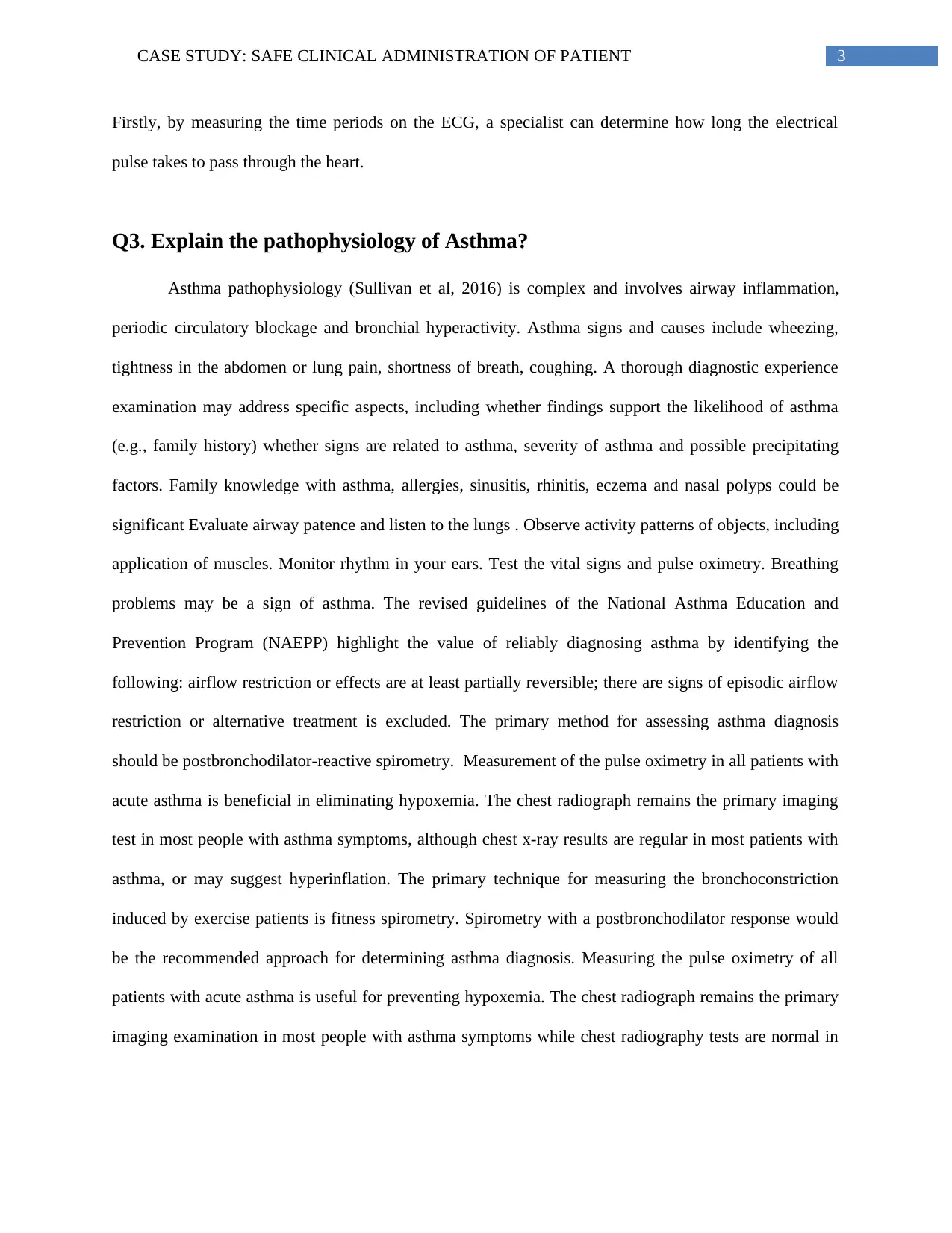
3CASE STUDY: SAFE CLINICAL ADMINISTRATION OF PATIENT
Firstly, by measuring the time periods on the ECG, a specialist can determine how long the electrical
pulse takes to pass through the heart.
Q3. Explain the pathophysiology of Asthma?
Asthma pathophysiology (Sullivan et al, 2016) is complex and involves airway inflammation,
periodic circulatory blockage and bronchial hyperactivity. Asthma signs and causes include wheezing,
tightness in the abdomen or lung pain, shortness of breath, coughing. A thorough diagnostic experience
examination may address specific aspects, including whether findings support the likelihood of asthma
(e.g., family history) whether signs are related to asthma, severity of asthma and possible precipitating
factors. Family knowledge with asthma, allergies, sinusitis, rhinitis, eczema and nasal polyps could be
significant Evaluate airway patence and listen to the lungs . Observe activity patterns of objects, including
application of muscles. Monitor rhythm in your ears. Test the vital signs and pulse oximetry. Breathing
problems may be a sign of asthma. The revised guidelines of the National Asthma Education and
Prevention Program (NAEPP) highlight the value of reliably diagnosing asthma by identifying the
following: airflow restriction or effects are at least partially reversible; there are signs of episodic airflow
restriction or alternative treatment is excluded. The primary method for assessing asthma diagnosis
should be postbronchodilator-reactive spirometry. Measurement of the pulse oximetry in all patients with
acute asthma is beneficial in eliminating hypoxemia. The chest radiograph remains the primary imaging
test in most people with asthma symptoms, although chest x-ray results are regular in most patients with
asthma, or may suggest hyperinflation. The primary technique for measuring the bronchoconstriction
induced by exercise patients is fitness spirometry. Spirometry with a postbronchodilator response would
be the recommended approach for determining asthma diagnosis. Measuring the pulse oximetry of all
patients with acute asthma is useful for preventing hypoxemia. The chest radiograph remains the primary
imaging examination in most people with asthma symptoms while chest radiography tests are normal in
Firstly, by measuring the time periods on the ECG, a specialist can determine how long the electrical
pulse takes to pass through the heart.
Q3. Explain the pathophysiology of Asthma?
Asthma pathophysiology (Sullivan et al, 2016) is complex and involves airway inflammation,
periodic circulatory blockage and bronchial hyperactivity. Asthma signs and causes include wheezing,
tightness in the abdomen or lung pain, shortness of breath, coughing. A thorough diagnostic experience
examination may address specific aspects, including whether findings support the likelihood of asthma
(e.g., family history) whether signs are related to asthma, severity of asthma and possible precipitating
factors. Family knowledge with asthma, allergies, sinusitis, rhinitis, eczema and nasal polyps could be
significant Evaluate airway patence and listen to the lungs . Observe activity patterns of objects, including
application of muscles. Monitor rhythm in your ears. Test the vital signs and pulse oximetry. Breathing
problems may be a sign of asthma. The revised guidelines of the National Asthma Education and
Prevention Program (NAEPP) highlight the value of reliably diagnosing asthma by identifying the
following: airflow restriction or effects are at least partially reversible; there are signs of episodic airflow
restriction or alternative treatment is excluded. The primary method for assessing asthma diagnosis
should be postbronchodilator-reactive spirometry. Measurement of the pulse oximetry in all patients with
acute asthma is beneficial in eliminating hypoxemia. The chest radiograph remains the primary imaging
test in most people with asthma symptoms, although chest x-ray results are regular in most patients with
asthma, or may suggest hyperinflation. The primary technique for measuring the bronchoconstriction
induced by exercise patients is fitness spirometry. Spirometry with a postbronchodilator response would
be the recommended approach for determining asthma diagnosis. Measuring the pulse oximetry of all
patients with acute asthma is useful for preventing hypoxemia. The chest radiograph remains the primary
imaging examination in most people with asthma symptoms while chest radiography tests are normal in
Paraphrase This Document
Need a fresh take? Get an instant paraphrase of this document with our AI Paraphraser
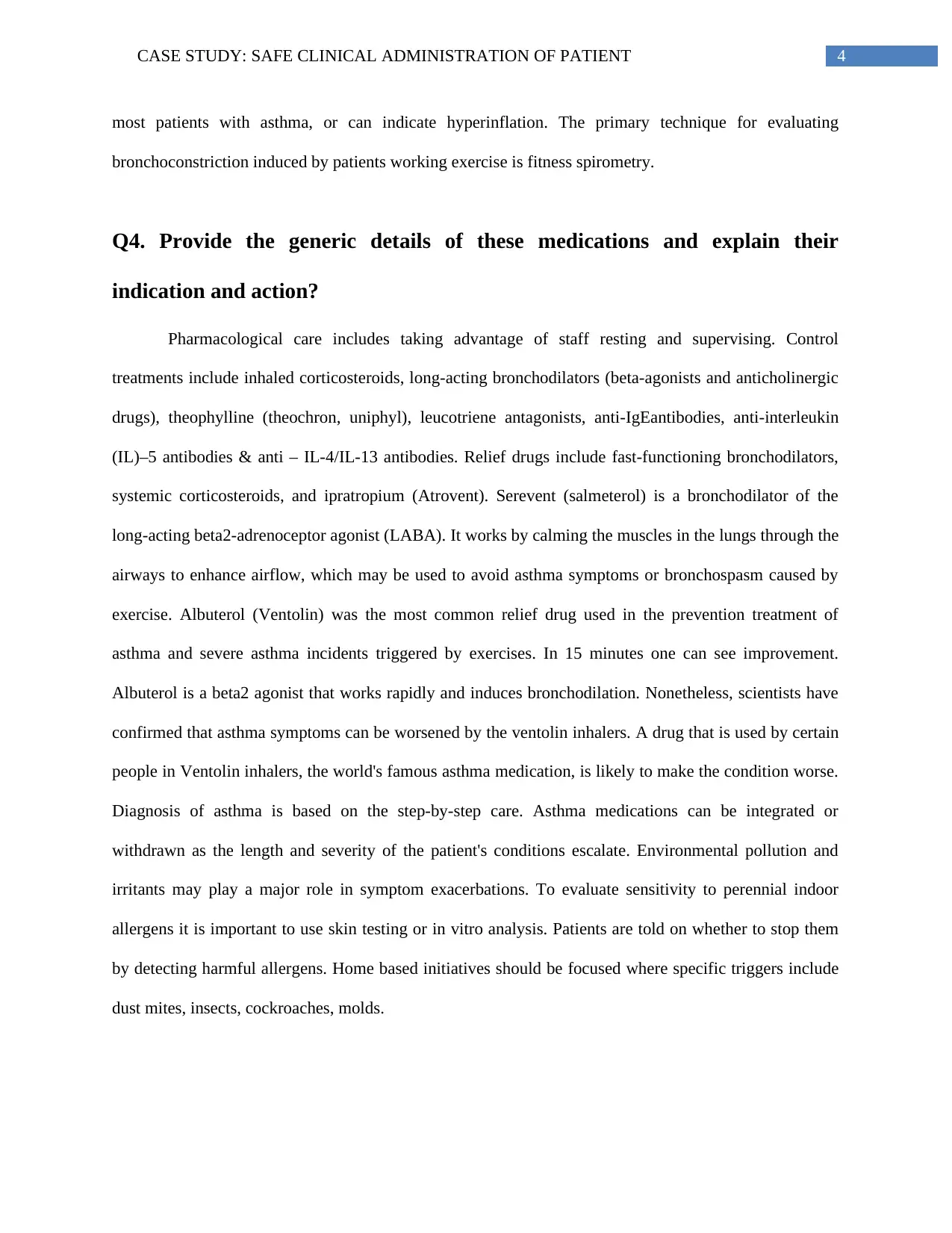
4CASE STUDY: SAFE CLINICAL ADMINISTRATION OF PATIENT
most patients with asthma, or can indicate hyperinflation. The primary technique for evaluating
bronchoconstriction induced by patients working exercise is fitness spirometry.
Q4. Provide the generic details of these medications and explain their
indication and action?
Pharmacological care includes taking advantage of staff resting and supervising. Control
treatments include inhaled corticosteroids, long-acting bronchodilators (beta-agonists and anticholinergic
drugs), theophylline (theochron, uniphyl), leucotriene antagonists, anti-IgEantibodies, anti-interleukin
(IL)–5 antibodies & anti – IL-4/IL-13 antibodies. Relief drugs include fast-functioning bronchodilators,
systemic corticosteroids, and ipratropium (Atrovent). Serevent (salmeterol) is a bronchodilator of the
long-acting beta2-adrenoceptor agonist (LABA). It works by calming the muscles in the lungs through the
airways to enhance airflow, which may be used to avoid asthma symptoms or bronchospasm caused by
exercise. Albuterol (Ventolin) was the most common relief drug used in the prevention treatment of
asthma and severe asthma incidents triggered by exercises. In 15 minutes one can see improvement.
Albuterol is a beta2 agonist that works rapidly and induces bronchodilation. Nonetheless, scientists have
confirmed that asthma symptoms can be worsened by the ventolin inhalers. A drug that is used by certain
people in Ventolin inhalers, the world's famous asthma medication, is likely to make the condition worse.
Diagnosis of asthma is based on the step-by-step care. Asthma medications can be integrated or
withdrawn as the length and severity of the patient's conditions escalate. Environmental pollution and
irritants may play a major role in symptom exacerbations. To evaluate sensitivity to perennial indoor
allergens it is important to use skin testing or in vitro analysis. Patients are told on whether to stop them
by detecting harmful allergens. Home based initiatives should be focused where specific triggers include
dust mites, insects, cockroaches, molds.
most patients with asthma, or can indicate hyperinflation. The primary technique for evaluating
bronchoconstriction induced by patients working exercise is fitness spirometry.
Q4. Provide the generic details of these medications and explain their
indication and action?
Pharmacological care includes taking advantage of staff resting and supervising. Control
treatments include inhaled corticosteroids, long-acting bronchodilators (beta-agonists and anticholinergic
drugs), theophylline (theochron, uniphyl), leucotriene antagonists, anti-IgEantibodies, anti-interleukin
(IL)–5 antibodies & anti – IL-4/IL-13 antibodies. Relief drugs include fast-functioning bronchodilators,
systemic corticosteroids, and ipratropium (Atrovent). Serevent (salmeterol) is a bronchodilator of the
long-acting beta2-adrenoceptor agonist (LABA). It works by calming the muscles in the lungs through the
airways to enhance airflow, which may be used to avoid asthma symptoms or bronchospasm caused by
exercise. Albuterol (Ventolin) was the most common relief drug used in the prevention treatment of
asthma and severe asthma incidents triggered by exercises. In 15 minutes one can see improvement.
Albuterol is a beta2 agonist that works rapidly and induces bronchodilation. Nonetheless, scientists have
confirmed that asthma symptoms can be worsened by the ventolin inhalers. A drug that is used by certain
people in Ventolin inhalers, the world's famous asthma medication, is likely to make the condition worse.
Diagnosis of asthma is based on the step-by-step care. Asthma medications can be integrated or
withdrawn as the length and severity of the patient's conditions escalate. Environmental pollution and
irritants may play a major role in symptom exacerbations. To evaluate sensitivity to perennial indoor
allergens it is important to use skin testing or in vitro analysis. Patients are told on whether to stop them
by detecting harmful allergens. Home based initiatives should be focused where specific triggers include
dust mites, insects, cockroaches, molds.
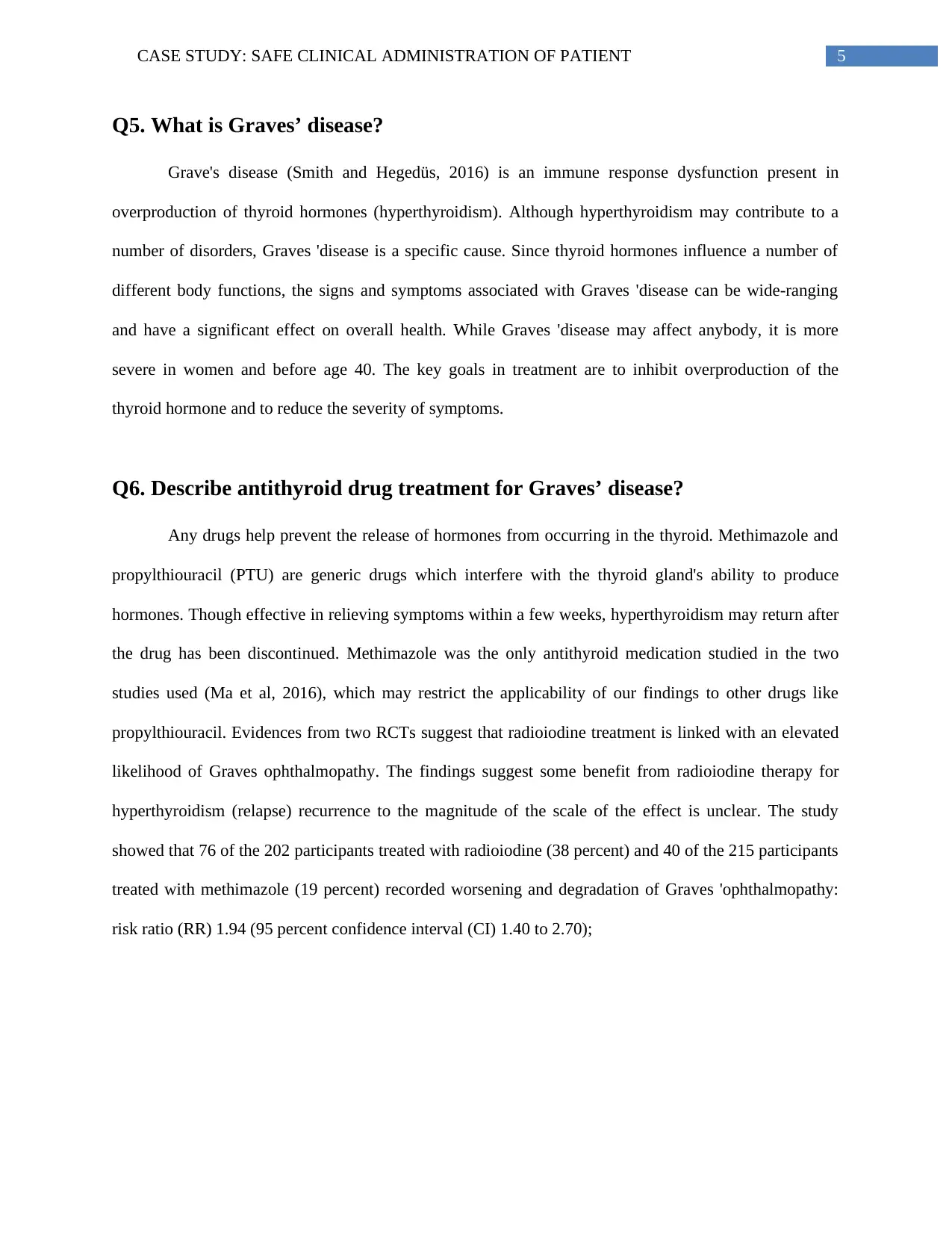
5CASE STUDY: SAFE CLINICAL ADMINISTRATION OF PATIENT
Q5. What is Graves’ disease?
Grave's disease (Smith and Hegedüs, 2016) is an immune response dysfunction present in
overproduction of thyroid hormones (hyperthyroidism). Although hyperthyroidism may contribute to a
number of disorders, Graves 'disease is a specific cause. Since thyroid hormones influence a number of
different body functions, the signs and symptoms associated with Graves 'disease can be wide-ranging
and have a significant effect on overall health. While Graves 'disease may affect anybody, it is more
severe in women and before age 40. The key goals in treatment are to inhibit overproduction of the
thyroid hormone and to reduce the severity of symptoms.
Q6. Describe antithyroid drug treatment for Graves’ disease?
Any drugs help prevent the release of hormones from occurring in the thyroid. Methimazole and
propylthiouracil (PTU) are generic drugs which interfere with the thyroid gland's ability to produce
hormones. Though effective in relieving symptoms within a few weeks, hyperthyroidism may return after
the drug has been discontinued. Methimazole was the only antithyroid medication studied in the two
studies used (Ma et al, 2016), which may restrict the applicability of our findings to other drugs like
propylthiouracil. Evidences from two RCTs suggest that radioiodine treatment is linked with an elevated
likelihood of Graves ophthalmopathy. The findings suggest some benefit from radioiodine therapy for
hyperthyroidism (relapse) recurrence to the magnitude of the scale of the effect is unclear. The study
showed that 76 of the 202 participants treated with radioiodine (38 percent) and 40 of the 215 participants
treated with methimazole (19 percent) recorded worsening and degradation of Graves 'ophthalmopathy:
risk ratio (RR) 1.94 (95 percent confidence interval (CI) 1.40 to 2.70);
Q5. What is Graves’ disease?
Grave's disease (Smith and Hegedüs, 2016) is an immune response dysfunction present in
overproduction of thyroid hormones (hyperthyroidism). Although hyperthyroidism may contribute to a
number of disorders, Graves 'disease is a specific cause. Since thyroid hormones influence a number of
different body functions, the signs and symptoms associated with Graves 'disease can be wide-ranging
and have a significant effect on overall health. While Graves 'disease may affect anybody, it is more
severe in women and before age 40. The key goals in treatment are to inhibit overproduction of the
thyroid hormone and to reduce the severity of symptoms.
Q6. Describe antithyroid drug treatment for Graves’ disease?
Any drugs help prevent the release of hormones from occurring in the thyroid. Methimazole and
propylthiouracil (PTU) are generic drugs which interfere with the thyroid gland's ability to produce
hormones. Though effective in relieving symptoms within a few weeks, hyperthyroidism may return after
the drug has been discontinued. Methimazole was the only antithyroid medication studied in the two
studies used (Ma et al, 2016), which may restrict the applicability of our findings to other drugs like
propylthiouracil. Evidences from two RCTs suggest that radioiodine treatment is linked with an elevated
likelihood of Graves ophthalmopathy. The findings suggest some benefit from radioiodine therapy for
hyperthyroidism (relapse) recurrence to the magnitude of the scale of the effect is unclear. The study
showed that 76 of the 202 participants treated with radioiodine (38 percent) and 40 of the 215 participants
treated with methimazole (19 percent) recorded worsening and degradation of Graves 'ophthalmopathy:
risk ratio (RR) 1.94 (95 percent confidence interval (CI) 1.40 to 2.70);
⊘ This is a preview!⊘
Do you want full access?
Subscribe today to unlock all pages.

Trusted by 1+ million students worldwide
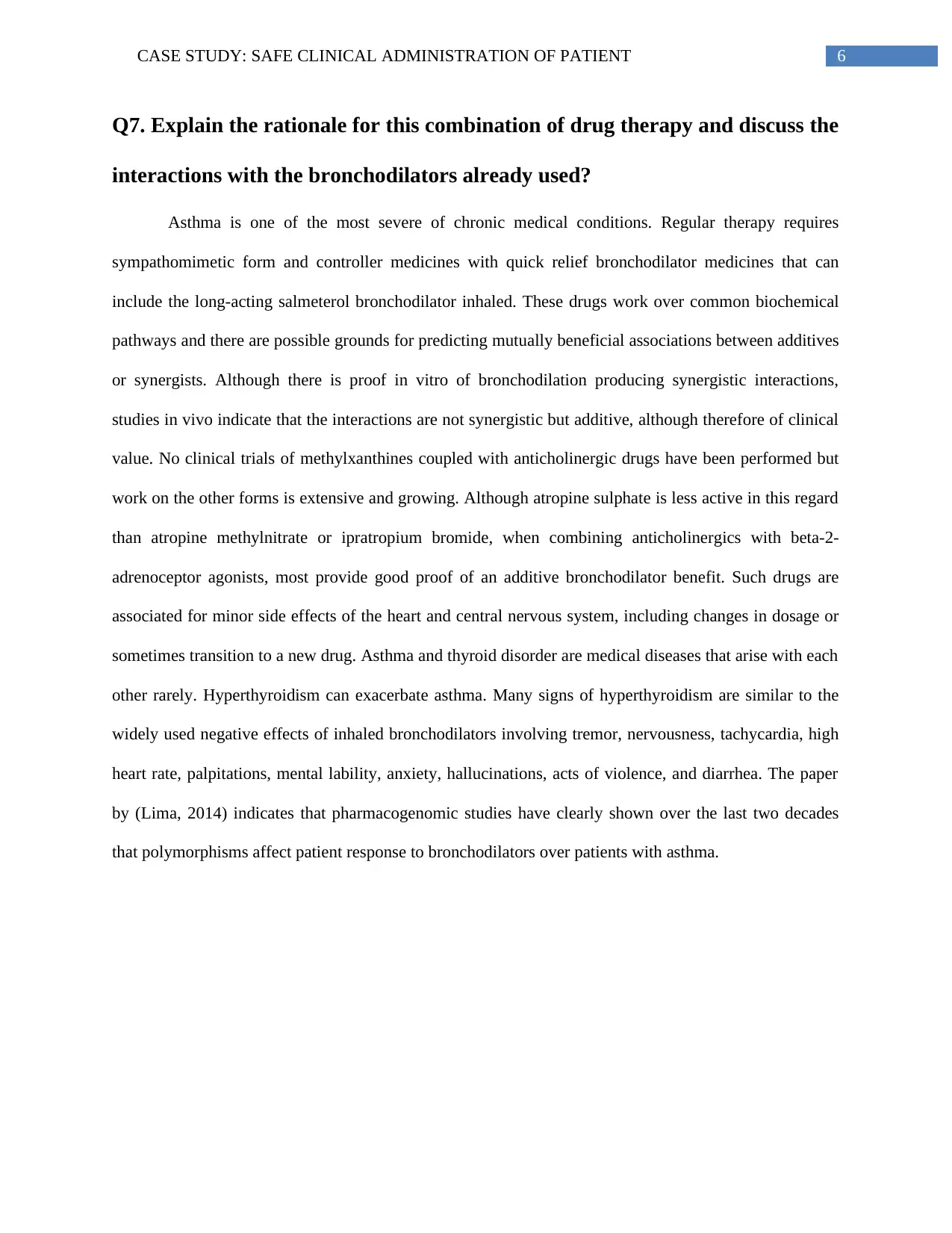
6CASE STUDY: SAFE CLINICAL ADMINISTRATION OF PATIENT
Q7. Explain the rationale for this combination of drug therapy and discuss the
interactions with the bronchodilators already used?
Asthma is one of the most severe of chronic medical conditions. Regular therapy requires
sympathomimetic form and controller medicines with quick relief bronchodilator medicines that can
include the long-acting salmeterol bronchodilator inhaled. These drugs work over common biochemical
pathways and there are possible grounds for predicting mutually beneficial associations between additives
or synergists. Although there is proof in vitro of bronchodilation producing synergistic interactions,
studies in vivo indicate that the interactions are not synergistic but additive, although therefore of clinical
value. No clinical trials of methylxanthines coupled with anticholinergic drugs have been performed but
work on the other forms is extensive and growing. Although atropine sulphate is less active in this regard
than atropine methylnitrate or ipratropium bromide, when combining anticholinergics with beta-2-
adrenoceptor agonists, most provide good proof of an additive bronchodilator benefit. Such drugs are
associated for minor side effects of the heart and central nervous system, including changes in dosage or
sometimes transition to a new drug. Asthma and thyroid disorder are medical diseases that arise with each
other rarely. Hyperthyroidism can exacerbate asthma. Many signs of hyperthyroidism are similar to the
widely used negative effects of inhaled bronchodilators involving tremor, nervousness, tachycardia, high
heart rate, palpitations, mental lability, anxiety, hallucinations, acts of violence, and diarrhea. The paper
by (Lima, 2014) indicates that pharmacogenomic studies have clearly shown over the last two decades
that polymorphisms affect patient response to bronchodilators over patients with asthma.
Q7. Explain the rationale for this combination of drug therapy and discuss the
interactions with the bronchodilators already used?
Asthma is one of the most severe of chronic medical conditions. Regular therapy requires
sympathomimetic form and controller medicines with quick relief bronchodilator medicines that can
include the long-acting salmeterol bronchodilator inhaled. These drugs work over common biochemical
pathways and there are possible grounds for predicting mutually beneficial associations between additives
or synergists. Although there is proof in vitro of bronchodilation producing synergistic interactions,
studies in vivo indicate that the interactions are not synergistic but additive, although therefore of clinical
value. No clinical trials of methylxanthines coupled with anticholinergic drugs have been performed but
work on the other forms is extensive and growing. Although atropine sulphate is less active in this regard
than atropine methylnitrate or ipratropium bromide, when combining anticholinergics with beta-2-
adrenoceptor agonists, most provide good proof of an additive bronchodilator benefit. Such drugs are
associated for minor side effects of the heart and central nervous system, including changes in dosage or
sometimes transition to a new drug. Asthma and thyroid disorder are medical diseases that arise with each
other rarely. Hyperthyroidism can exacerbate asthma. Many signs of hyperthyroidism are similar to the
widely used negative effects of inhaled bronchodilators involving tremor, nervousness, tachycardia, high
heart rate, palpitations, mental lability, anxiety, hallucinations, acts of violence, and diarrhea. The paper
by (Lima, 2014) indicates that pharmacogenomic studies have clearly shown over the last two decades
that polymorphisms affect patient response to bronchodilators over patients with asthma.
Paraphrase This Document
Need a fresh take? Get an instant paraphrase of this document with our AI Paraphraser
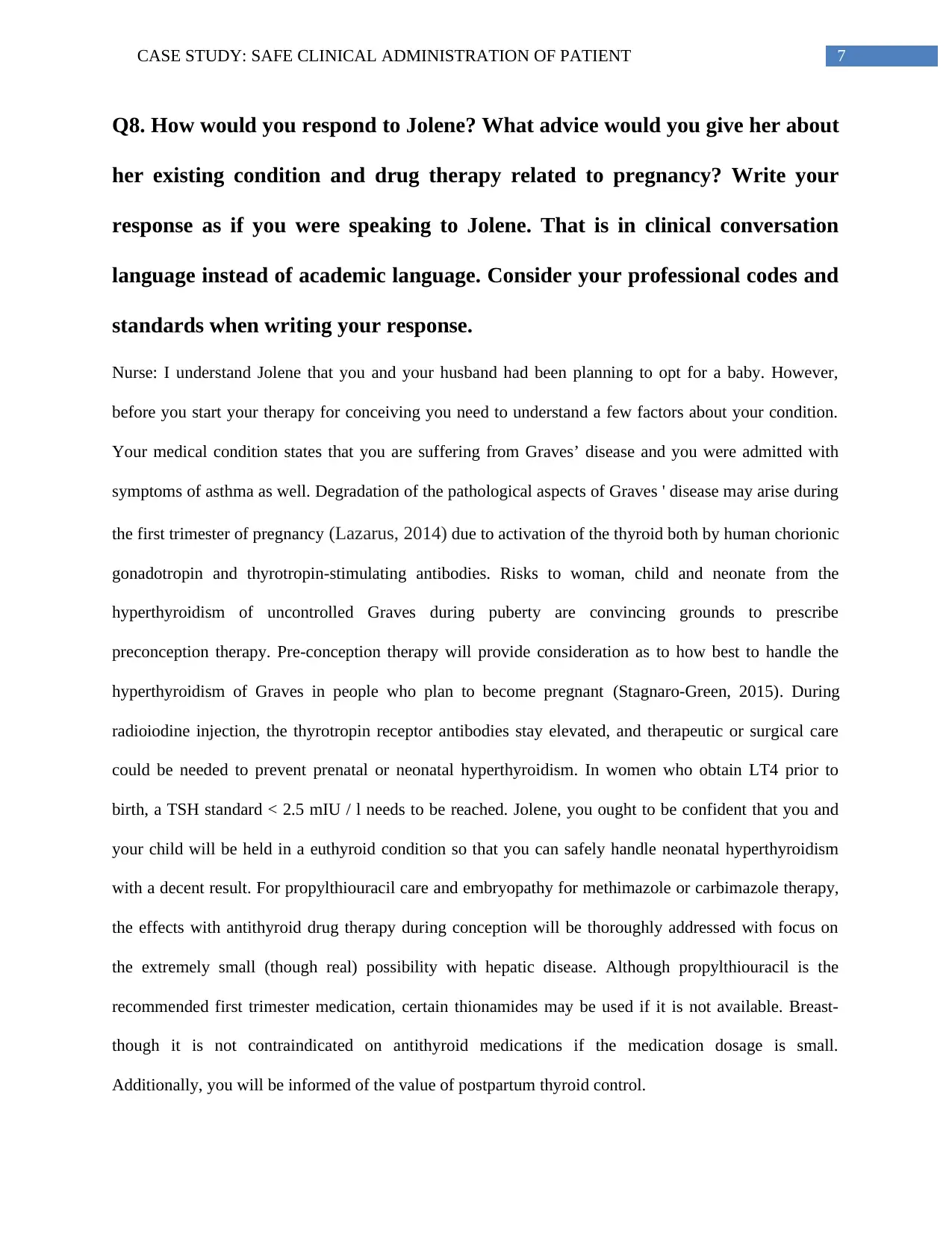
7CASE STUDY: SAFE CLINICAL ADMINISTRATION OF PATIENT
Q8. How would you respond to Jolene? What advice would you give her about
her existing condition and drug therapy related to pregnancy? Write your
response as if you were speaking to Jolene. That is in clinical conversation
language instead of academic language. Consider your professional codes and
standards when writing your response.
Nurse: I understand Jolene that you and your husband had been planning to opt for a baby. However,
before you start your therapy for conceiving you need to understand a few factors about your condition.
Your medical condition states that you are suffering from Graves’ disease and you were admitted with
symptoms of asthma as well. Degradation of the pathological aspects of Graves ' disease may arise during
the first trimester of pregnancy (Lazarus, 2014) due to activation of the thyroid both by human chorionic
gonadotropin and thyrotropin-stimulating antibodies. Risks to woman, child and neonate from the
hyperthyroidism of uncontrolled Graves during puberty are convincing grounds to prescribe
preconception therapy. Pre-conception therapy will provide consideration as to how best to handle the
hyperthyroidism of Graves in people who plan to become pregnant (Stagnaro-Green, 2015). During
radioiodine injection, the thyrotropin receptor antibodies stay elevated, and therapeutic or surgical care
could be needed to prevent prenatal or neonatal hyperthyroidism. In women who obtain LT4 prior to
birth, a TSH standard < 2.5 mIU / l needs to be reached. Jolene, you ought to be confident that you and
your child will be held in a euthyroid condition so that you can safely handle neonatal hyperthyroidism
with a decent result. For propylthiouracil care and embryopathy for methimazole or carbimazole therapy,
the effects with antithyroid drug therapy during conception will be thoroughly addressed with focus on
the extremely small (though real) possibility with hepatic disease. Although propylthiouracil is the
recommended first trimester medication, certain thionamides may be used if it is not available. Breast-
though it is not contraindicated on antithyroid medications if the medication dosage is small.
Additionally, you will be informed of the value of postpartum thyroid control.
Q8. How would you respond to Jolene? What advice would you give her about
her existing condition and drug therapy related to pregnancy? Write your
response as if you were speaking to Jolene. That is in clinical conversation
language instead of academic language. Consider your professional codes and
standards when writing your response.
Nurse: I understand Jolene that you and your husband had been planning to opt for a baby. However,
before you start your therapy for conceiving you need to understand a few factors about your condition.
Your medical condition states that you are suffering from Graves’ disease and you were admitted with
symptoms of asthma as well. Degradation of the pathological aspects of Graves ' disease may arise during
the first trimester of pregnancy (Lazarus, 2014) due to activation of the thyroid both by human chorionic
gonadotropin and thyrotropin-stimulating antibodies. Risks to woman, child and neonate from the
hyperthyroidism of uncontrolled Graves during puberty are convincing grounds to prescribe
preconception therapy. Pre-conception therapy will provide consideration as to how best to handle the
hyperthyroidism of Graves in people who plan to become pregnant (Stagnaro-Green, 2015). During
radioiodine injection, the thyrotropin receptor antibodies stay elevated, and therapeutic or surgical care
could be needed to prevent prenatal or neonatal hyperthyroidism. In women who obtain LT4 prior to
birth, a TSH standard < 2.5 mIU / l needs to be reached. Jolene, you ought to be confident that you and
your child will be held in a euthyroid condition so that you can safely handle neonatal hyperthyroidism
with a decent result. For propylthiouracil care and embryopathy for methimazole or carbimazole therapy,
the effects with antithyroid drug therapy during conception will be thoroughly addressed with focus on
the extremely small (though real) possibility with hepatic disease. Although propylthiouracil is the
recommended first trimester medication, certain thionamides may be used if it is not available. Breast-
though it is not contraindicated on antithyroid medications if the medication dosage is small.
Additionally, you will be informed of the value of postpartum thyroid control.
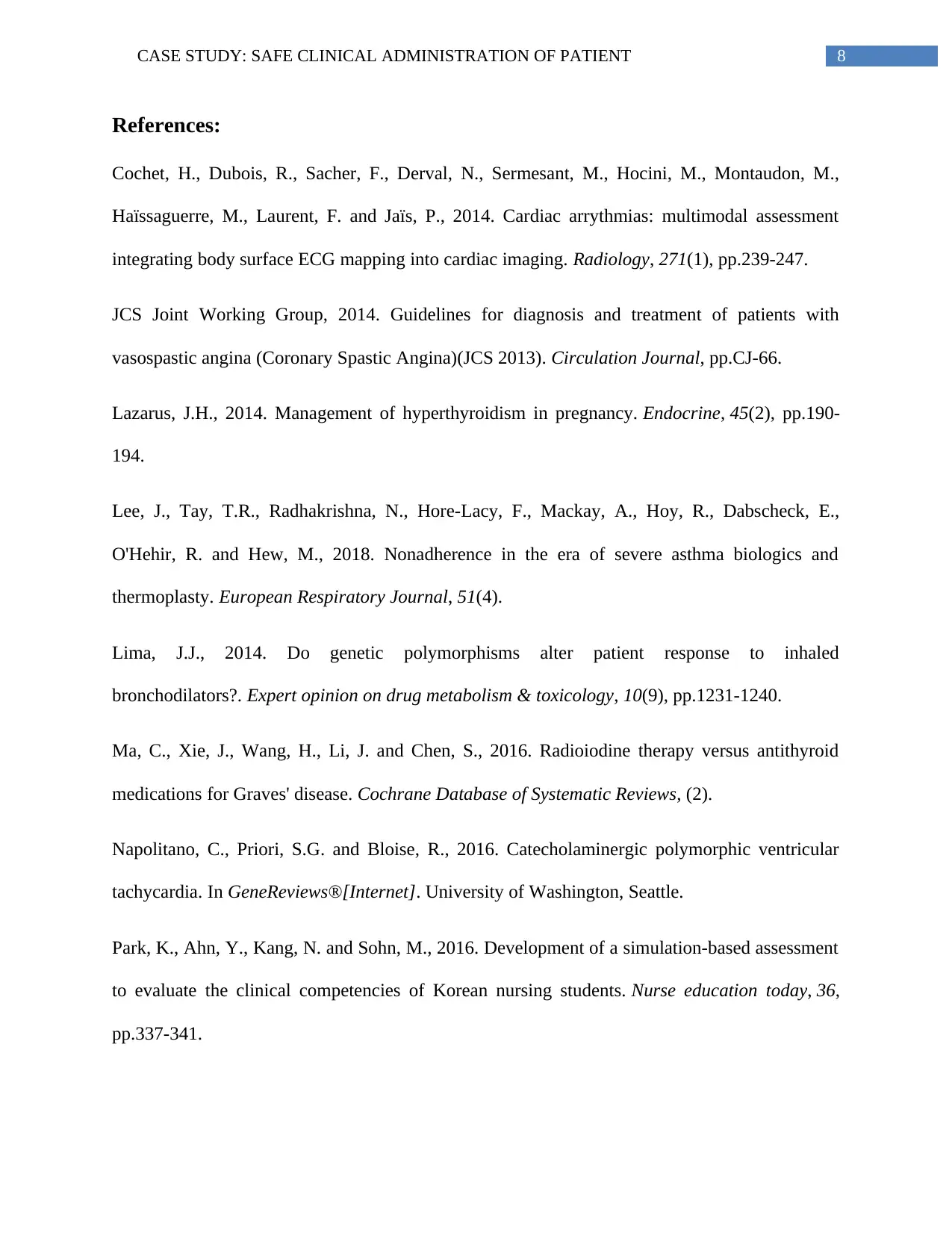
8CASE STUDY: SAFE CLINICAL ADMINISTRATION OF PATIENT
References:
Cochet, H., Dubois, R., Sacher, F., Derval, N., Sermesant, M., Hocini, M., Montaudon, M.,
Haïssaguerre, M., Laurent, F. and Jaïs, P., 2014. Cardiac arrythmias: multimodal assessment
integrating body surface ECG mapping into cardiac imaging. Radiology, 271(1), pp.239-247.
JCS Joint Working Group, 2014. Guidelines for diagnosis and treatment of patients with
vasospastic angina (Coronary Spastic Angina)(JCS 2013). Circulation Journal, pp.CJ-66.
Lazarus, J.H., 2014. Management of hyperthyroidism in pregnancy. Endocrine, 45(2), pp.190-
194.
Lee, J., Tay, T.R., Radhakrishna, N., Hore-Lacy, F., Mackay, A., Hoy, R., Dabscheck, E.,
O'Hehir, R. and Hew, M., 2018. Nonadherence in the era of severe asthma biologics and
thermoplasty. European Respiratory Journal, 51(4).
Lima, J.J., 2014. Do genetic polymorphisms alter patient response to inhaled
bronchodilators?. Expert opinion on drug metabolism & toxicology, 10(9), pp.1231-1240.
Ma, C., Xie, J., Wang, H., Li, J. and Chen, S., 2016. Radioiodine therapy versus antithyroid
medications for Graves' disease. Cochrane Database of Systematic Reviews, (2).
Napolitano, C., Priori, S.G. and Bloise, R., 2016. Catecholaminergic polymorphic ventricular
tachycardia. In GeneReviews®[Internet]. University of Washington, Seattle.
Park, K., Ahn, Y., Kang, N. and Sohn, M., 2016. Development of a simulation-based assessment
to evaluate the clinical competencies of Korean nursing students. Nurse education today, 36,
pp.337-341.
References:
Cochet, H., Dubois, R., Sacher, F., Derval, N., Sermesant, M., Hocini, M., Montaudon, M.,
Haïssaguerre, M., Laurent, F. and Jaïs, P., 2014. Cardiac arrythmias: multimodal assessment
integrating body surface ECG mapping into cardiac imaging. Radiology, 271(1), pp.239-247.
JCS Joint Working Group, 2014. Guidelines for diagnosis and treatment of patients with
vasospastic angina (Coronary Spastic Angina)(JCS 2013). Circulation Journal, pp.CJ-66.
Lazarus, J.H., 2014. Management of hyperthyroidism in pregnancy. Endocrine, 45(2), pp.190-
194.
Lee, J., Tay, T.R., Radhakrishna, N., Hore-Lacy, F., Mackay, A., Hoy, R., Dabscheck, E.,
O'Hehir, R. and Hew, M., 2018. Nonadherence in the era of severe asthma biologics and
thermoplasty. European Respiratory Journal, 51(4).
Lima, J.J., 2014. Do genetic polymorphisms alter patient response to inhaled
bronchodilators?. Expert opinion on drug metabolism & toxicology, 10(9), pp.1231-1240.
Ma, C., Xie, J., Wang, H., Li, J. and Chen, S., 2016. Radioiodine therapy versus antithyroid
medications for Graves' disease. Cochrane Database of Systematic Reviews, (2).
Napolitano, C., Priori, S.G. and Bloise, R., 2016. Catecholaminergic polymorphic ventricular
tachycardia. In GeneReviews®[Internet]. University of Washington, Seattle.
Park, K., Ahn, Y., Kang, N. and Sohn, M., 2016. Development of a simulation-based assessment
to evaluate the clinical competencies of Korean nursing students. Nurse education today, 36,
pp.337-341.
⊘ This is a preview!⊘
Do you want full access?
Subscribe today to unlock all pages.

Trusted by 1+ million students worldwide
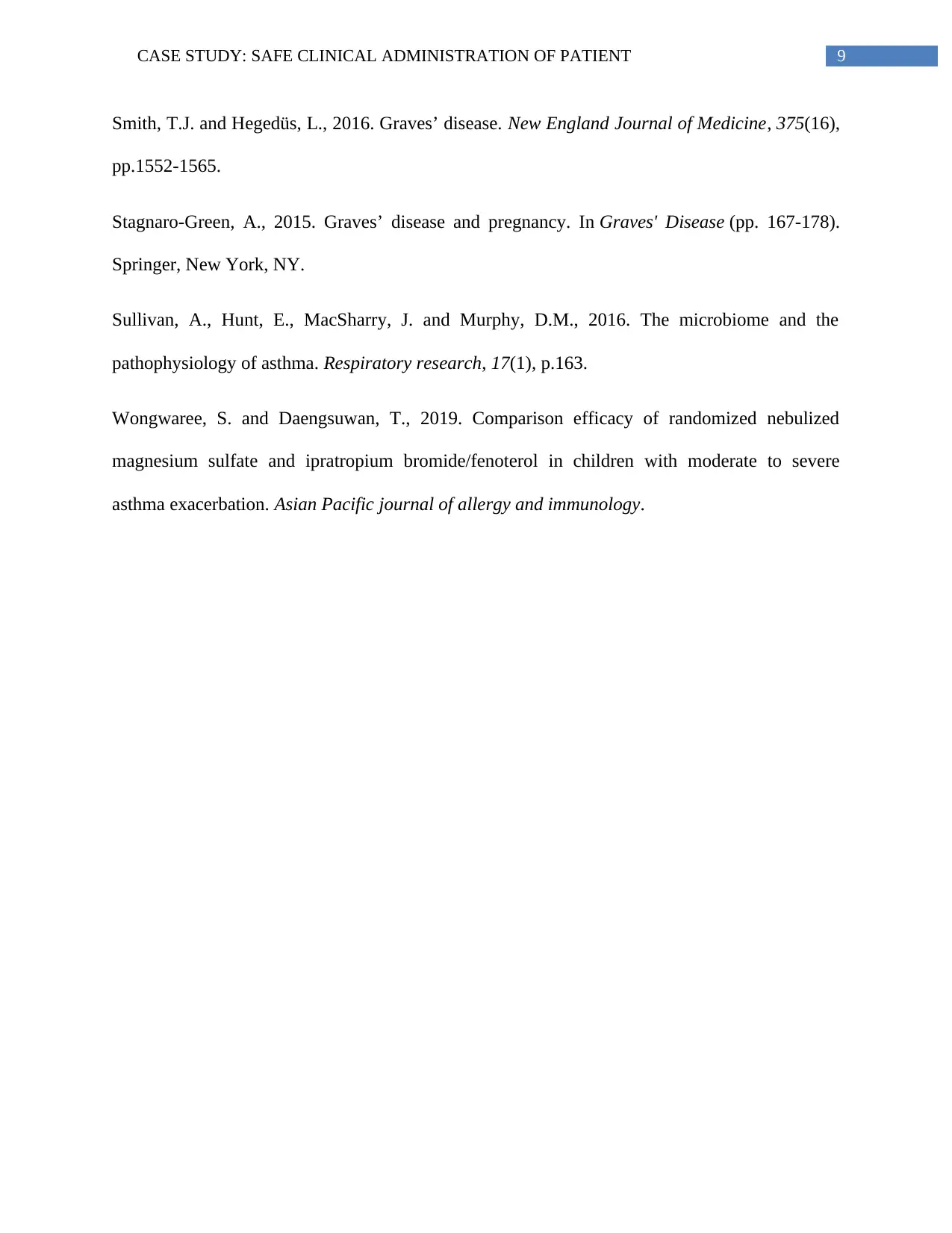
9CASE STUDY: SAFE CLINICAL ADMINISTRATION OF PATIENT
Smith, T.J. and Hegedüs, L., 2016. Graves’ disease. New England Journal of Medicine, 375(16),
pp.1552-1565.
Stagnaro-Green, A., 2015. Graves’ disease and pregnancy. In Graves' Disease (pp. 167-178).
Springer, New York, NY.
Sullivan, A., Hunt, E., MacSharry, J. and Murphy, D.M., 2016. The microbiome and the
pathophysiology of asthma. Respiratory research, 17(1), p.163.
Wongwaree, S. and Daengsuwan, T., 2019. Comparison efficacy of randomized nebulized
magnesium sulfate and ipratropium bromide/fenoterol in children with moderate to severe
asthma exacerbation. Asian Pacific journal of allergy and immunology.
Smith, T.J. and Hegedüs, L., 2016. Graves’ disease. New England Journal of Medicine, 375(16),
pp.1552-1565.
Stagnaro-Green, A., 2015. Graves’ disease and pregnancy. In Graves' Disease (pp. 167-178).
Springer, New York, NY.
Sullivan, A., Hunt, E., MacSharry, J. and Murphy, D.M., 2016. The microbiome and the
pathophysiology of asthma. Respiratory research, 17(1), p.163.
Wongwaree, S. and Daengsuwan, T., 2019. Comparison efficacy of randomized nebulized
magnesium sulfate and ipratropium bromide/fenoterol in children with moderate to severe
asthma exacerbation. Asian Pacific journal of allergy and immunology.
1 out of 10
Related Documents
Your All-in-One AI-Powered Toolkit for Academic Success.
+13062052269
info@desklib.com
Available 24*7 on WhatsApp / Email
![[object Object]](/_next/static/media/star-bottom.7253800d.svg)
Unlock your academic potential
Copyright © 2020–2025 A2Z Services. All Rights Reserved. Developed and managed by ZUCOL.





